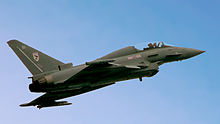Indonesian Space Force Command
Komando Untuk Keamanan Luar Angkasa
Dari Angkatan Antariksa Indonesia
"Kami Menjelajahi Alam Raya untuk Menemukan Keagungan Sang Maha Kuasa"
~Gen. Arip Nurahman~
(Komando Pasukan Khusus Angkatan Antariksa Indonesia)
(Korps Pasukan Khas Angkatan Udara)
Jet-powered fighters
It has become common in the aviation community to classify jet fighters by "generations" for historical purposes. There
are no official definitions of these generations; rather, they
represent the notion that there are stages in the development of fighter
design approaches, performance capabilities, and technological
evolution.
The
timeframes associated with each generation are inexact and are only
indicative of the period during which their design philosophies and
technology employment enjoyed a prevailing influence on fighter design
and development. These timeframes also encompass the peak period of
service entry for such aircraft.
4.5th generation jet fighters (1990s to the present)
The end of the Cold War in 1991 led many governments to significantly decrease military spending as a "peace dividend". Air force inventories were cut, and
research and development programs intended to produce what was then
anticipated to be "fifth-generation" fighters took serious hits; many
programs were canceled during the first half of the 1990s, and those
which survived were "stretched out". While the practice of slowing the
pace of development reduces annual investment expenses, it comes at the
penalty of increased overall program and unit costs over the long-term.
In this instance, however, it also permitted designers to make use of the tremendous achievements being made in the fields of computers, avionics and other flight electronics, which had become possible largely due to the advances made in microchip and semiconductor technologies in the 1980s and 1990s. This opportunity enabled designers to develop fourth-generation designs – or redesigns – with significantly enhanced capabilities. These improved designs have become known as "Generation 4.5" fighters, recognizing their intermediate nature between the 4th and 5th generations, and their contribution in furthering development of individual fifth-generation technologies.
In this instance, however, it also permitted designers to make use of the tremendous achievements being made in the fields of computers, avionics and other flight electronics, which had become possible largely due to the advances made in microchip and semiconductor technologies in the 1980s and 1990s. This opportunity enabled designers to develop fourth-generation designs – or redesigns – with significantly enhanced capabilities. These improved designs have become known as "Generation 4.5" fighters, recognizing their intermediate nature between the 4th and 5th generations, and their contribution in furthering development of individual fifth-generation technologies.
The
primary characteristics of this sub-generation are the application of
advanced digital avionics and aerospace materials, modest signature
reduction (primarily RF "stealth"), and highly integrated systems and
weapons. These fighters have been designed to operate in a "network-centric" battlefield environment and are principally multirole aircraft. Key weapons technologies introduced include beyond-visual-range (BVR) AAMs; Global Positioning System (GPS)-guided weapons, solid-state phased-array radars; helmet-mounted sights; and improved secure, jamming-resistant datalinks.
Thrust vectoring to further improve transient maneuvering capabilities
have also been adopted by many 4.5th generation fighters, and uprated
powerplants have enabled some designs to achieve a degree of "supercruise" ability. Stealth characteristics are focused primarily on frontal-aspect radar cross section (RCS) signature-reduction techniques including radar-absorbent materials (RAM), L-O coatings and limited shaping techniques.
"Half-generation"
designs are either based on existing airframes or are based on new
airframes following similar design theory as previous iterations;
however, these modifications have introduced the structural use of
composite materials to reduce weight, greater fuel fractions to
increase range, and signature reduction treatments to achieve lower RCS
compared to their predecessors. Prime examples of such aircraft, which
are based on new airframe designs making extensive use of carbon-fibre composites, include the Eurofighter Typhoon, Dassault Rafale, and Saab JAS 39 Gripen NG.
Apart
from these fighter jets, most of the 4.5 generation aircraft are
actually modified variants of existing airframes from the earlier
fourth generation fighter jets. Such fighter jets are generally heavier
and examples include the Boeing F/A-18E/F Super Hornet which is an evolution of the 1970s F/A-18 Hornet design, the F-15E Strike Eagle which is a ground-attack variant of the Cold War-era F-15 Eagle, the Sukhoi Su-30MKI which is a further development of the Su-30 fighter and the Mikoyan MiG-29M/35, an upgraded version of the 1980s MiG-29. The Su-30MKI and MiG-35 use two- and three-dimensional thrust vectoring engines respectively so as to enhance maneuvering. Most 4.5 generation aircraft are being retrofitted with Active Electronically Scanned Array (AESA) radars and other state-of-the art avionics such as electronic counter-measure systems and forward looking infrared.
4.5
generation fighters first entered service in the early 1990s, and most
of them are still being produced and evolved. It is quite possible
that they may continue in production alongside fifth-generation
fighters due to the expense of developing the advanced level of stealth
technology needed to achieve aircraft designs featuring very low
observables (VLO), which is one of the defining features of
fifth-generation fighters. Of the 4.5th generation designs, only the
Super Hornet, Strike Eagle, and the Rafale have seen combat action.
The
United States Government defines 4.5 generation fighter aircraft as
those that "(1) have advanced capabilities, including— (A) AESA radar;
(B) high capacity data-link; and (C) enhanced avionics; and (2) have
the ability to deploy current and reasonably foreseeable advanced
armaments."
- See also: List of 4.5 generation jet fighters
Powered By:
Tentara Nasional Indonesia Angkatan Darat (Indonesian Army)
Tentara Nasional Indonesia Angkatan Laut (Indonesian Navy)
Tentara Nasional Indonesia Angkatan Udara (Indonesian Air Force)
Sumber: Wikipedia





































No comments:
Post a Comment